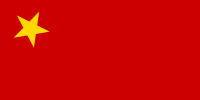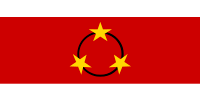Lai Teck
| Lai Teck | |
|---|---|
| Born |
Hoang A Nhac[1] or Phạm Văn Đắc[2] 1901[3] Nghệ Tĩnh Province, Annam[4] |
| Disappeared | 6 March 1947 (aged 45–46) |
| Died |
1947 (aged 45–46) Bangkok, Thailand |
| Cause of death | Suffocation |
| Resting place | Menam River |
| Residence | Vietnam, Malaya, Singapore |
| Nationality | Vietnamese/Malayan |
| Other names | Lai Tek, Loi Tak, Lee Soong,[3] Wong Kim Geok,[5] Chang Hung, Mr. Wright[6] |
| Occupation | Politician, spy |
| Years active | 1934–1947 |
| Known for | Secretary-General of the Malayan Communist Party |
| Political party |
Malayan People's Anti-Japanese Army Malayan Communist Party |
Lai Teck real name Phạm Văn Đắc, born in the Bà Rịa (now Bà Rịa-Vũng Tàu Province)[7] was a leader of the Communist Party of Malaya and Malayan People's Anti-Japanese Army. A Vietnamese of mixed Sino-Vietnamese descent,[6][8] Prior to his arrival in Malaya, Lai Teck was believed to have led his life as Truong Phuoc Dat until 1934, during which Dat disappeared and Lai Teck appeared.[9]
Biography
Lai Teck was a shadowy character whose real name and background are unknown. According to his successor Chin Peng, He curiously chose the party alias 'Wright' which, given the Chinese pronunciation of English words beginning with the letter 'r' soon became distorted to Lai Te. This was further mangled, depending on who was writing or speaking English, to 'Loi Teck', 'Lai Teck' and 'Lighter'.[10]
Lai Teck was believed to have served the French as a spy in Indo-China but been uncovered. It was subsequently alleged that he was recruited by the British security services and brought to Singapore in 1934 to infiltrate the CPM. In 1938, he became the Secretary-General of the Malayan Communist Party.[11] At this he was highly successful, and by using the British police to pick off his rivals within the Party he rose through the hierarchy and attained the Party leadership (Secretary General) in April 1939. Perhaps because of this, he steered the Party on a course of non-confrontation with the British and wholly embraced the Communist International's new line of co-operation with the United States and the Western European powers against Nazi Germany and Japan.
Although many of the CPM's top personnel managed to flee Singapore before it fell, Lai Teck did not and was picked up in a Japanese sweep shortly after. Although most communists were executed by the Japanese, Lai Teck walked free a few days later. Based on later evidence, including documents in Japanese archives, it now appears most likely that Lai Teck saved his life by promising to act as a Japanese agent.
On 1 September 1942, more than 100 senior CPM and MPAJA members gathered at the Batu Caves just north of Kuala Lumpur for a secret conference. The Japanese, however, had been tipped off and staged a surprise raid at dawn. In the ensuing lopsided skirmish most of the CPM and MPAJA high command were destroyed. Lai Teck, who should have been at the meeting, wasn't. Subsequently, he claimed that he had been unable to attend because his car broke down.
Disappearance
In 1946, faint rumours which had been circulating within the party about disloyalty on the part of Lai Teck began to receive more substantiation. This was exacerbated by the restlessness of the rank and file, especially the younger members, who favoured radical action. Lai Teck was removed from some sensitive posts, and an investigation was begun into his activities. A full meeting of the Central Executive Committee was scheduled for 6 March 1947 at which the complaints against Lai Teck were to be aired in his presence. Lai Teck did not attend but instead absconded with the bulk of the Party's funds, hiding first in Singapore, then going to Hong Kong and later to Thailand.
Aftermath
With Lai Teck gone, the party elected a new leader, Chin Peng. According to Chin Peng, Lai Teck was killed in Bangkok some time in 1947 when Thai Communists tried to capture him. Lai Teck was suffocated during the struggle, he was put into the gunny-sack and tossed into the Menam River.[12] It is heavily suspected that Chin Peng himself called for and executed the assassination of Lai Teck, although he vehemently denied this.
See also
References
- ↑ Journal of the Malaysian Branch of the Royal Asiatic Society Volume 83, Part 2, September 2010, No. 299 E- ISSN 2180-4338 Print ISSN 0128-5483 doi:10.1353/ras.2010.0005
- ↑
- 1 2 Robert Payne (1951). Red storm over Asia. Macmillan. p. 288.
- ↑ University of Madras (1980). The Indian Year Book of International Affairs. University of Madras. p. 406.
- ↑ Constance Mary Turnbull (1989). A History of Singapore, 1819-1988. Oxford University Press. p. 147. ISBN 0-19-588911-8.
- 1 2 Cheah Boon Kheng (1992). From Pki to the Comintern, 1924-1941. SEAP Publications. p. 28. ISBN 0-87727-125-9.
- ↑
- ↑ Carl A. Trocki (2005). Singapore: Wealth, Power And The Culture Of Control. Routledge. p. 103. ISBN 0-415-26385-9.
- ↑ Judge, Sophie Quinn, Ho Chi Minh: The Missing Years, 1919-1941, C. Hurst & Co. Publishers, 2003, ISBN 1850656584
- ↑ Chin Peng, My Side of History, as told to Ian Ward and Norman Miraflor, Media Masters, Singapore, 2003, p 58.
- ↑ Cheah Boon Kheng (1992). From Pki to the Comintern, 1924-1941. SEAP Publications. pp. 26–7. ISBN 0-87727-125-9.
- ↑ Chin Peng, My Side of History, pp 189-190.

